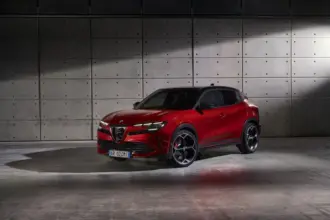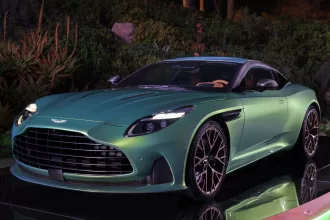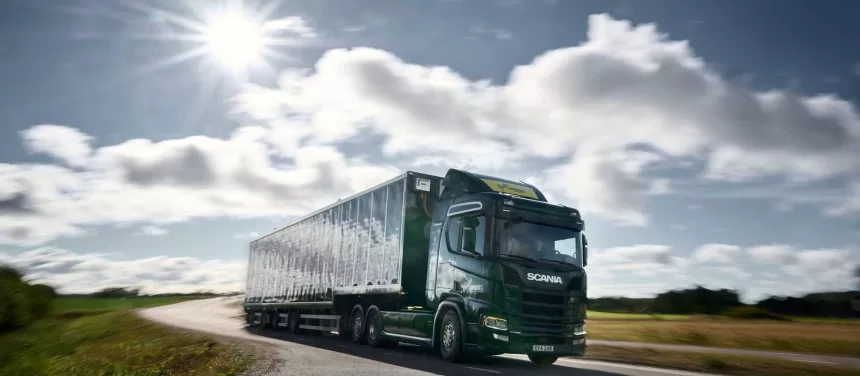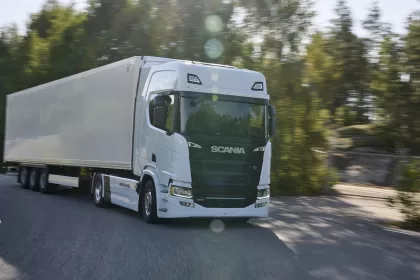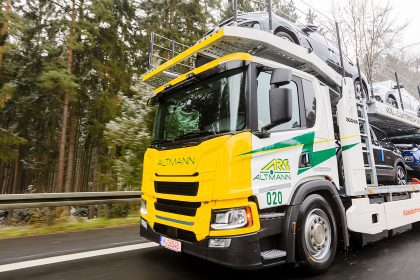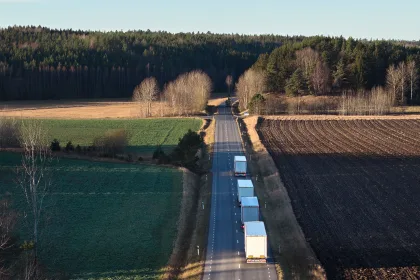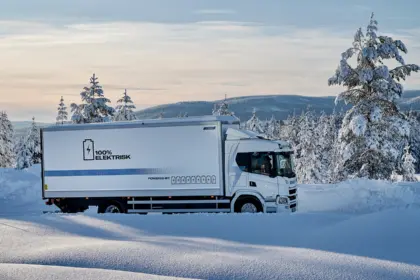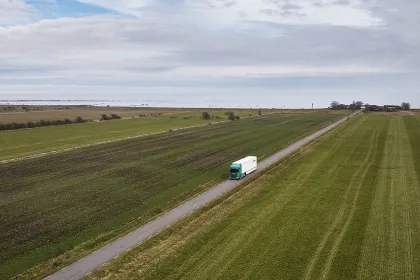Scania’s intensive development of tomorrow’s electrified transport solutions is inspiring many new technological ideas. One of those is a project to develop a solar-powered truck, whose electrical propulsion is generated by the vehicle’s own solar cells, sited in a trailer that’s attached to a hybrid-electric vehicle.
It’s an imaginative undertaking that has seen a small teamwork in an agile setting to come up with solutions that both build on Scania’s modular system and create new technologies. The finished prototype has been handed over to long-term Scania haulage customer and partner Ernst Express, who will test it in actual operational conditions on Swedish roads.
“When we first began thinking about this more than three years ago, our starting point was the lithium-ion batteries that are used in battery-electric trucks. In the time that Scania has been working with that technology, we’ve seen the batteries become lighter, cheaper and more energy-dense,” explains Eric Falkgrim, a Technology Leader at Scania’s Research and Innovation department and the Project Manager for the solar-powered truck.
“We asked ourselves: ‘What if solar cells show a similar trend? If the efficiency of the cells doubles, the cost halves or drops away a lot, is there a breakeven point?’ We wanted to find out if it makes sense to develop this technology.”
An initial six-month pre-study in late 2019 and early 2020 made the team realise that it did make sense to explore this technology now. Once they’d received funding from the Swedish state innovation agency Vinnova, a full-scale project began in January 2021, with solar cell development by Uppsala University.
However, the project is focused on Sweden, not exactly known for constant sunshine, especially in the colder months. Why so?
“We specifically wanted to see if it made sense in Sweden because if you go to places such as Southern Europe, Australia or North Africa, there’s obviously a lot more sunshine. If it can work here in the less sunny and somewhat darker conditions then that would confirm the widespread validity of the project,” says Falkgrim.
Scania’s ‘start-up’ development team
The small tightly-knit Scania team consists of software developers, hardware developers and project management, with no more than a dozen people involved over the 19-month development process.
“It’s a bit like a start-up,” says Falkgrim.
“We knew very early on what we wanted to do. The overall task seems simple – putting solar panels on a truck and plugging it in to the electrical system.
“But it’s a little bit of a wild and crazy idea because it comes with a lot of new hardware and software systemisation and development, to make it safe to handle the transfer of power, and to handle faults. The plug-in hybrid truck/tractor with all the ‘regular systems’ (100 kWh energy storage) is connected to the trailer with additional batteries, which have 200 kWh energy storage and act as a ‘power bank’ for the truck, and they’re connected to the solar panel box that charges the power bank,” he explains.
There are also important safety considerations.
“You have to bear in mind that solar cells are not made to be moving around town in a vehicle. They’re designed to sit stationary on top of a house for 20 or 30 years. We’ve had to address safety challenges in putting solar panels on a vehicle.
“So it’s fairly involved from a technical point of view, but we don’t have that pressure of it being a full-scale project where we’re producing something that will be sold globally to hundreds and thousands of customers. It’s a research project that’s about seeing if the solution makes sense, and so far we believe it does. We’re pleased to have the cooperation of Ernst Express, who partnered with us in the Swedish e-Highway project. They know that this is a trial with the possibility of technical snags that we’ll have to fix.”
Potential long-term energy benefits
Apart from testing the actual solar-cell technology in a truck-trailer setting, Eric Falkgrim also emphasises the potential benefits for the energy industry. Indeed, the project has benefited from the support of Swedish energy company Dalakraft.
“This could have repercussions for the energy industry. If you scale up the solution you could have thousands of vehicles connected to the grid, so this could have implications for buying and selling electricity to and from the grid.”
He adds, “I think there’s a natural development in the industry where energy provision and the transport industry are growing together. There’s a real symbiosis with electrical vehicles. You can produce your own electricity and you can drive on your own electricity, which is a completely new situation.”
Though a commercial application for the truck is some years away, Eric Falkgrim is excited about the handover to Ernst Express and by the long-term prospects of solar-cell technology.
“The data we already have says that solar panels do contribute significantly to the energy you’re getting for the truck, and it’s one part of the overall puzzle when it comes to decarbonised transport. The first thing we need to find out is ‘does this make sense?’ And to answer that: yes, it’s good enough to work on the scale that we are doing now.”


